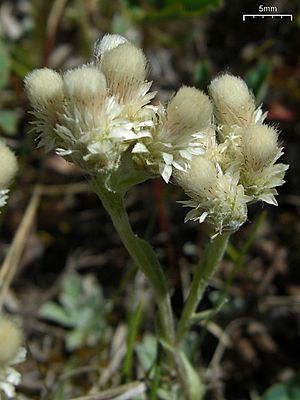Small-leaf pussytoes facts for kids
Quick facts for kids Small-leaf pussytoes |
|
|---|---|
 |
|
| Conservation status | |
| Scientific classification | |
| Genus: |
Antennaria
|
| Species: |
parvifolia
|
| Synonyms | |
|
Synonymy
Antennaria aprica Greene
Antennaria aureola Lunell Antennaria holmii Greene Antennaria latisquamea Greene 1905 not Piper 1901 Antennaria minuscula B.Boivin Antennaria obtusata Greene Antennaria pumila Greene Antennaria recurva Greene Antennaria rhodantha Suksd. |
|
Meet Antennaria parvifolia, also known as Nuttall's pussytoes or small-leaf pussytoes! This interesting plant is a type of flowering plant from North America. It belongs to the daisy or aster family.
Contents
Where Does Nuttall's Pussytoes Grow?
Nuttall's pussytoes grows naturally across central and western North America. You can find it in many places! It lives in Canada, the United States, and northern Mexico. Its range stretches from British Columbia in the west all the way to Ontario in the east. It also grows south into California, Chihuahua, and Nuevo León. However, it hasn't been seen in California since 1987.
What Does This Plant Look Like?
Antennaria parvifolia is usually a small plant. It often grows only a few centimeters tall. But sometimes, it can reach up to 15 centimeters (about 6 inches) high.
Its leaves are grayish and feel a bit fuzzy, like wool. They can grow up to 3.5 centimeters long. The leaves closer to the ground are usually wider and longer than the ones higher up on the stem.
At the top of the plant, you'll find clusters of 2 to 7 flower heads. These aren't single flowers. Instead, they are groups of many tiny flowers packed together. The flower heads are surrounded by special leaf-like parts called phyllaries. These phyllaries can be different colors. They might be white, red, green, or brown.
After the flowers bloom, the plant produces small fruits. These fruits are called achenes. Each achene has a fluffy, parachute-like part called a pappus. This pappus helps the fruit float on the wind. This way, the plant's seeds can travel far away and grow in new places.
How Does Nuttall's Pussytoes Reproduce?
This plant has a few ways to make new plants. It can spread by sending out special stems called stolons. These stolons grow along the ground. New stems and plants can sprout up from them, forming a mat.
Antennaria parvifolia can also reproduce using seeds. Some plants have only female flowers. Other plants have both male and female flowers. In places like Colorado and New Mexico, you might find both male and female plants. These plants can reproduce the usual way, by mixing genetic material. However, male plants are much less common than female ones.
In most other areas, the plants are mostly female. They can make seeds without needing a male plant. This special way of reproducing is called apomixis. It means the plant essentially clones itself through its seeds.
Why Is This Plant Important?
In Colorado, Antennaria parvifolia is known as an indicator species. This means it can tell us something about its environment. If you see a lot of this plant, it might mean the land has been overgrazed. Overgrazing happens when too many animals eat the plants in an area. When land is heavily grazed, this plant often becomes more common.
Nuttall's pussytoes can grow in many different places. It likes areas where the ground has been disturbed. It can also grow in a wide variety of ecosystems and different types of soil.


